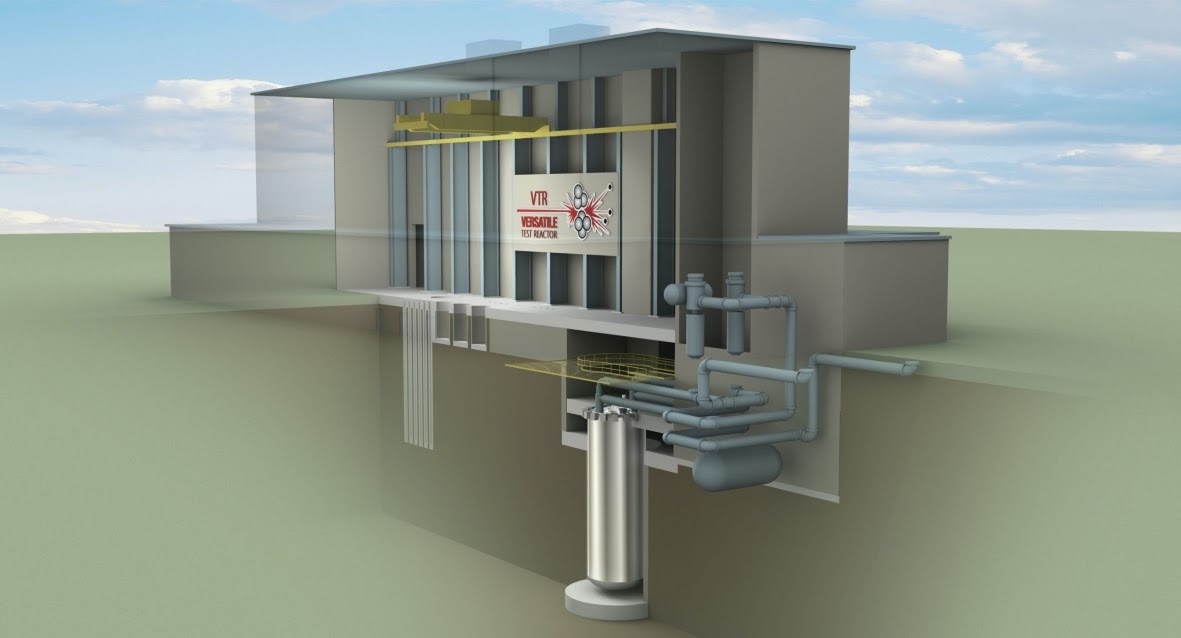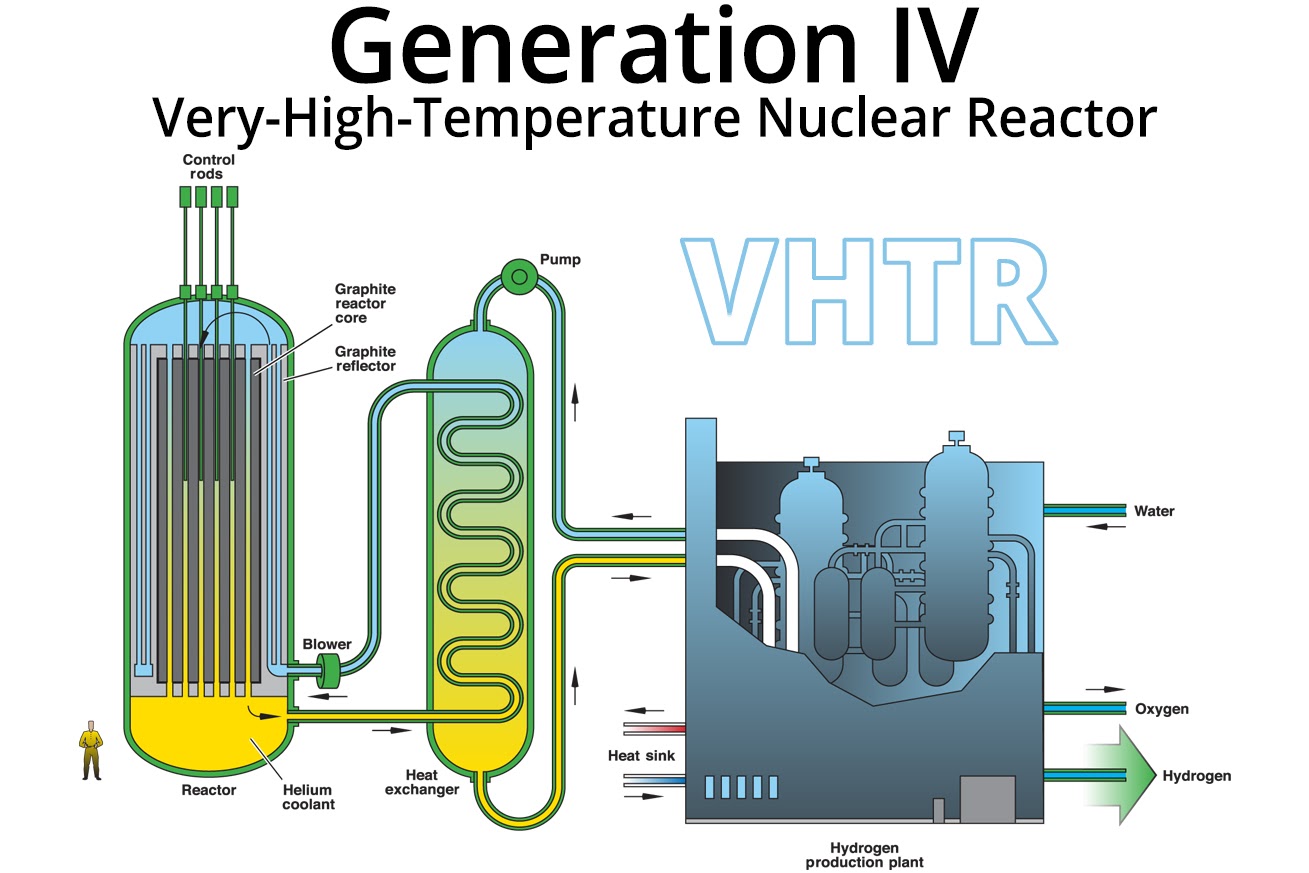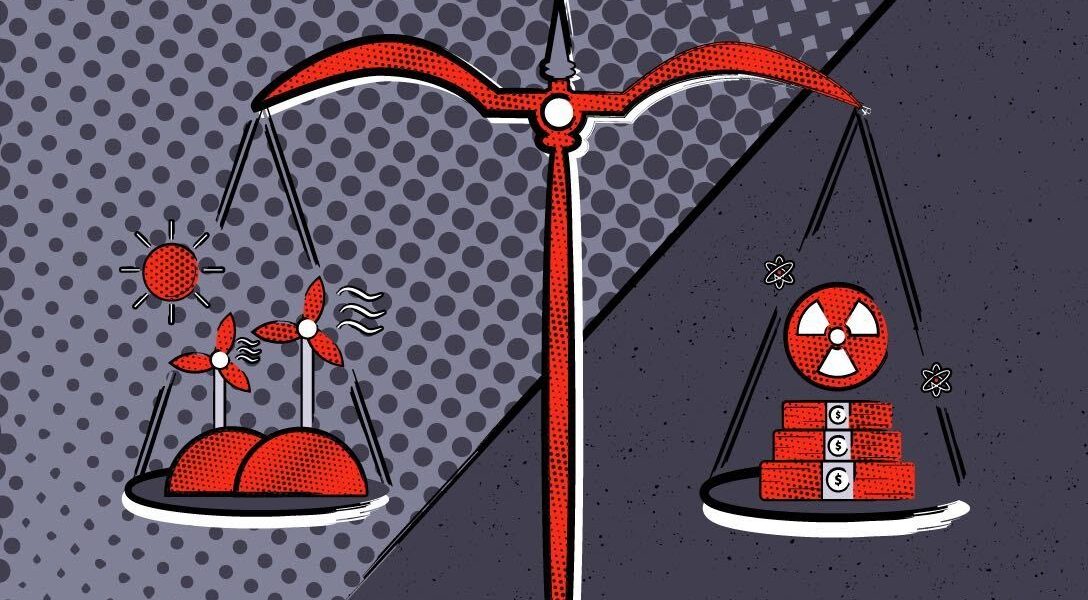Nuclear tech startups promise a climate change solution in exchange for heavy government subsidies. Whether they’ll deliver in time is a gamble some are not willing to take.
Standing before a packed auditorium at the annual conference of the federal Nuclear Regulatory Commission (NRC) in 2019, Nathan Myhrvold readied his pitch to revive a dying industry: “I’m gonna talk about boosting innovation in nuclear energy.”
Myhrvold, a former chief technology officer at Microsoft, is accustomed to working in Silicon Valley’s Big Tech, where innovation depends on breaking rules and setting aggressive timelines — risky behavior when translated to the nuclear sector, and yet standard operating procedure for private nuclear energy companies vying for public money to get their startups off the ground.
These startups aren’t promoting the types of reactors that Three Mile Island made infamous: massive cores covered in concrete domes, with trunk-like cooling towers that dominate the landscape — and the possibility of meltdowns caused by human or electrical failure. Instead, Myhrvold and others are touting “advanced” reactors designed to be smaller, safer, and cheaper than the shrinking fleet of nuclear power plants operating today.
In an emergency, advanced reactors would shut down virtually by themselves, without the need for operators or motor-driven pumps to intervene. Natural phenomena like gravity or buoyancy would do the job. That feature and their 3 to 50 times smaller power output and size would make site choice more flexible, the argument goes, so that reactors could be placed in shuttered coal mines, at military bases, in remote towns with minimal electricity demands, and closer to cities. Capital costs would decrease rapidly over time as factories churn out modular designs en masse. The amount of radioactive waste would decrease an estimated 100-fold, as reactors could recycle fuel and use it more efficiently.
Pointing to these improvements, proponents expect advanced reactors to succeed where decades-old nuclear reactors have failed due to high capital costs, debatable public safety, and long construction times.
Some advocates see advanced nuclear reactors playing another important role — mitigating climate change. The technology certainly has friends in very high places: In his climate platform, which calls for carbon-free electricity by 2035, President Biden highlights advanced nuclear as one of the tools to use against climate change.
On the other hand, critics argue that advanced nuclear reactors run the risk of becoming boutique items, diverting billions in tax dollars that could be spent on improving existing solutions such as wind and solar coupled with battery storage. They also say that the plants aren’t nearly ready for prime time. Their cooling systems, relying on liquid metals, molten salts, or gas instead of water, were tested briefly in the 1950s and 1960s but were never fully developed. The concentrated uranium fuel the plants are designed to burn isn’t commercially available in the US, and there are no facilities to test how that fuel would work in reality.
“If you’re about climate, I wouldn’t be talking about advanced reactors that are not light-water reactors at all,” said Arjun Makhijani, who heads the nonprofit Institute for Energy and Environmental Research. “That’s simply because it’s toys for the boys, basically.”
Awards and Expectations
Myhrvold is the co-founder and vice chair of TerraPower, a Washington-based nuclear design and engineering company that in October 2020 received an $80 million award from the Department of Energy to build its first-of-a-kind Natrium reactor within seven years. As long as Congress appropriates funds each year, the DOE intends to spend up to $1.6 billion on the reactor and expects TerraPower to raise at least the same amount.
The award is one of many, totaling $230 million in 2020 alone, doled out to 10 companies under the DOE’s Advanced Reactor Demonstration Program (ARDP), launched last year. The program is meant to kick-start the private sector’s interest in developing the next generation of nuclear reactors, Generation IV.
But in recent years, deadlines for any kind of nuclear innovation have been unmet. The George W. Bush administration expected to usher in a nuclear renaissance and bring Generation III+ reactors online by 2010. No dice. Under Barack Obama, the only orders for these reactors were abandoned or incomplete as of 2020.
Trump’s DOE skipped Generation III+ entirely and advertised that Generation IV would debut by 2030.
Despite criticism and missed deadlines, nuclear innovators like TerraPower remain undeterred.
“Of all the clean-energy technologies, advanced nuclear offers the surest and fastest pathway to decarbonizing our economy,” TerraPower claims. In support of the company’s DOE award, the Nuclear Energy Institute, the industry’s trade association, stated that “rapid progress on the pathway towards deployment is more critical than ever to address our climate challenges and secure a carbon-free future across the world.”
Department of Energy Investments
Old-Style Nuclear
Construction on all 94 nuclear reactors currently operating in the United States began before the end of the 1970s. By 1983, more than 120 reactors that had already been ordered were scrapped due to delays that doubled construction time to more than 10 years and shot project costs through the roof. A lack of parts and skilled labor, shifting rules and safety requirements, and competition from cheap coal-generated electricity made nuclear’s already questionable economics look even worse.
In 1985, with no new nuclear plants on the horizon, Forbes ran a cover story that read: “The failure of the U.S. nuclear power program ranks as the largest managerial disaster in business history, a disaster on a monumental scale. … Only the blind, or the biased, can now think that the money has been well spent.”
Things haven’t changed much since that sobering assessment. The only orders for nuclear reactors in decades were either abandoned less than halfway through construction, as in the case of the VC Summer plant in South Carolina, or remain behind schedule at a tripled cost of $27 billion, as with the Vogtle plant in Georgia. In both cases, utility ratepayers were locked into covering more than $2 billion in construction costs for the next two decades, whether the project was finished or not.
“The fact is — and I don’t want my message to be misconstrued in this part — I don’t think we’re building any more [conventional] nuclear plants in the United States,” said William von Hoene at the US Energy Association’s 2018 public policy forum. Von Hoene should know: He is senior vice president of Exelon, which operates the largest fleet of nuclear reactors in the US.
Meanwhile, the NRC, the commission overseeing reactor safety, held a public meeting last month to propose granting up to three 20-year extensions of any plant’s usual 40-year lifetime, to eke out what use is left in the existing fleet.
Myhrvold clarified the implications when he commented to the commission at its own conference: “If you don’t build new plants, you don’t have a nuclear industry.”
Yet as of now, advanced reactors exist only on paper. And though Myhrvold touted their cost benefits, he admitted that “we need to get these plants built in order to actually find if that’s true.”
Please, Sir, I Want Some More
To move Generation IV from blueprint to build, Myhrvold told his NRC audience, “Every nuclear company has one fuel it completely needs, and that’s vast mountains of cash. You burn money long before you burn uranium.”
An audience member asked why Myhrvold is having trouble attracting private money, given that he is “one of the few people on the planet who has friends that could afford to lose tens of billions even and not feel the difference.”
Myhrvold, who spent 14 years alongside top brass at Microsoft, counts Bill Gates and Warren Buffett as friends. In fact, Gates is TerraPower’s co-founder, its majority investor, and chair of its board. TerraPower was incubated by Intellectual Ventures, a company Myhrvold launched in 2000 that at the time was backed by $6 billion from the likes of Google, Intel, Sony, and Microsoft.
Surprising as it may seem, TerraPower’s financial goals are still falling short. “It turns out that people that could afford to lose $10 billion, they still don’t like to,” Myhrvold told his questioner.
Taxpayer dollars, on the other hand, seem to be fair game.
The Department of Energy’s ARDP funding announcement promised to foot 50 percent to 80 percent of the bill for various advanced reactor projects. Applicants came out of the woodwork with diverse designs in various stages of planning. Only TerraPower and X-energy managed to convince the DOE that their designs could be fully functional within seven years, a deadline the department set.
Industry experts responded to the announcement by calling the deadline “aggressive but feasible” if a laundry list of concerns were addressed — concerns that add to the technology’s price tag.
One of the concerns focuses on the fuel most advanced reactors rely on, which has a higher-than-usual uranium concentration and isn’t sold commercially anywhere outside Russia. Additionally, the infrastructure to test the fuel before use doesn’t exist yet. Even before the ARDP’s launch, nuclear vendors were lobbying the DOE to remedy these oversights. Since 2018, Congress has pumped millions of dollars into designing a Versatile Test Reactor (VTR) that would evaluate advanced nuclear fuel and materials. It’s projected to cost up to $6 billion over the next five years.
Myhrvold stressed the need for testing under real-world conditions. “We need to do that before we build our reactor,” he said. “Not after.” Building testing facilities, he added, is “the kind of investment that I think the government has to make.”

Nuclear vendors aren’t shy about making their needs heard. The Nuclear Energy Institute spent more than $2 million in 2020 on lobbyists, the majority of whom previously held government positions. TerraPower’s own Jeff Navin, in charge of external affairs, was the DOE’s acting and deputy chief of staff under Obama and now navigates Washington, DC, to drum up billions for advanced nuclear power.
TerraPower tripled its lobbying expenses within the last three years, spending $320,000 in 2020 alone to push for the VTR facility and fuel procurement — but the company seems less willing to share in the expenses. The Senate recently denied the DOE’s request to quadruple VTR funding in the 2021 budget, and expressed concern that the department is “proceeding with plans for the VTR without having secured commitments from private companies or foreign governments for monetary and in-kind contributions.”
Responding to the funding announcement, members of the industry provided a wish list: They asked for a larger cut of the awards early on, rather than equal amounts over the entire project timeline. They asked to be guaranteed more than a single year’s award so they wouldn’t have to await Congress’s approval each year. They asked the DOE to drum up customers for them since there are currently next to none. The DOE refused on all counts.
However, the department did give in to the plea for “aggressive schedules for licensing” through the NRC, to at least stand a chance of deploying their reactors within seven years. To supporters, expedited licensing is code for getting rid of outdated regulations.
To critics, it’s an invitation to cut corners.
Gutting Safety, Cutting Costs
“What I worry about,” said Edwin Lyman, director of nuclear power safety at the Union of Concerned Scientists, “because there’s still so much pressure to make these projects not break the bank, to keep their cost down, [is] that all the developers are counting on an accelerated licensing process, exemptions from any important safety and security requirements that they think will give them a leg up and allow them to license these things faster and bring down the operating costs.”
Along those lines, the NRC is already considering a rule to shrink the zone within which plants must have evacuation plans to protect residents from radiation. For large-scale plants, it’s a radius of 10 miles. Some advanced-nuclear advocates argue for a 1,000-foot radius, practically within plant boundaries, meaning that developers would not have to draft evacuation plans or even notify the public of a radioactive release. Reactors could also be located closer to population centers — a major selling point.

In a separate request to the NRC, the Nuclear Energy Institute and other stakeholders asked for a rule change to let reactors be sited within communities of 25,000 residents or fewer.
Industry requests for regulatory relief were encouraged in the Nuclear Energy Innovation and Modernization Act, signed by Trump in 2018 to break down licensing barriers for advanced nuclear technology. In a letter of support, the DOE said the new way of rulemaking “accurately reflects the technological advances in reactor design, gained nuclear industry experiences, and regulatory guidance updates while ensuring that there is no undue risk to public health and safety.”
Despite these assurances, the NRC’s new regulatory framework is itself not yet fully developed nor free of gray areas. The only Generation IV design that uses water as a coolant, drafted by the startup NuScale, has recently undergone the NRC’s safety review, but its ongoing licensing process has been a 10-year slog that keeps pushing the limits of safety regulation.
In August 2020, the NRC issued NuScale a Final Evaluation Safety Report. Despite the document’s title, the approval was only conditional, and the findings have been controversial. Issues with the reactor’s shielding wall, possible leakage of combustible gases, and the strength of steam generator tubes remain unresolved. The NRC allowed NuScale to put off finding a fix until a later licensing stage, and publicized its “commitment to timely licensing of safe technologies for new, advanced reactors.”
Although the report acknowledged these shortcomings, it was silent about a flaw with the reactor’s cooling system that the independent Advisory Committee on Reactor Safeguards criticized late in the review process, commenting that “the completeness of the risk insights cannot be validated with confidence at this time.” Again NRC staffers deferred requiring a fix.
“I think [the NRC was] under the gun to meet an artificial deadline and show the industry and Congress that they’re not standing in the way of these exciting new technologies, and this embarrassing safety flaw came up late in the game,” said Lyman. “A lot of people in their rush to close the books didn’t notice this problem, or deliberately didn’t notice it and when it came to light they had to fix it in a hurry. [To make sure] it didn’t disrupt the schedule too much, I think they took liberties with the requirements they should have applied.”
What the Future Holds
Industry’s place at the table has thus far been guarded by both sides of the aisle. Recently, the push for advanced nuclear reactors has spawned several pieces of legislation designed to rush Generation IV plants into existence before the close of the decade.
When the Nuclear Energy Innovation and Modernization Act, aimed at overhauling the NRC’s safety review, didn’t yield results quickly enough, a bipartisan bloc of lawmakers wrote a letter reminding commissioners that “our nation’s nuclear innovators are aggressively working to deploy advanced nuclear technologies” and that it is “imperative the NRC’s advanced reactor rulemaking keep pace.”
When the Nuclear Energy Leadership Act, meant to keep the reactor demonstration projects alive, stalled for more than a year on both the Senate and House floors, lawmakers packaged it as a matter of national security and tacked it onto this year’s defense spending bill. They argued the US needed to compete with Russia’s and China’s “state-backed financing to reshape global energy policy.” Both countries, alongside Canada and the United Kingdom, are among the most vocal supporters of Generation IV reactors.
Industry pressure was also evident shortly after the Green New Deal resolution first appeared online, along with a fact sheet that called for phasing out nuclear reactors entirely. A few hours later, that piece of the plan was nixed.
Clearly, advocates hope that Biden’s climate plan continues to leave the door open to advanced nuclear power. But whether pressure and hope will push advanced reactors from pipe dream to reality is up for debate.
Lobbyists are faced with some hard-to-ignore examples of why advanced nuclear may not be a climate change solution after all. NuScale has already spent more than 12 years in the pre-application and licensing phase and expects to labor at least another decade to complete its first plant — if the remaining safety issues are resolved and customers materialize. So far their project already suffered a five-year delay and doubled in cost.
Despite this evidence, TerraPower and other advanced nuclear startups have promised to deploy in seven years. At least that’s their most recent estimate: They fell short of their initially hoped-for 2020 deadline, which set a pace that TerraPower’s own engineers called the “speed of light” in nuclear terms. But even at that speed, seven years is a long time when federal funds are already stretched thin and climate change is becoming more evident with each passing season.
“There isn’t enough money to let a thousand flowers bloom,” said Lyman. “As much as people hate the idea of government picking winners and losers, there has to be a systematic and logical process for allocating those resources, which shouldn’t be haphazard, which shouldn’t just be based on who has the better PR firm or lobbying power or more advocates in the DOE bureaucracy.”
Makhijani is more blunt. “It’s very distressing to see people with money and power push something that is utterly futile as a climate solution,” he said. “You may have some other reason to want nuclear power, but be frank about it, put it on the table, and let’s talk about it. But for climate? No. It’s a waste of money and time and a diversion of public’s attention and resources.”
Related front page panorama photo credit: WhoWhatWhy, Jake Mueller



